Operation: Berlin
Date: 24/25th March 1944 (Friday/Saturday)
Squadron: 625 Squadron
Type: Lancaster I
Serial:. ME684
Code: CF-V
Base: RAF Kelstern, Lincolnshire
Location: near Varsseveld
Pilot: Fl/Lt. “Knobby” Norman Arthur Wadham Clark 55000 RAFVR PoW No: Camp: Stalag Luft Barth Vogelsang
Fl/Eng: Sgt. “Curly” Donald Beckwith 1481231 RAFVR Evaded capture
Air/Bmr: F/O. Alex D.W. Bull J/23233 RCAF Age 20. PoW No: 4153 Camp: Stalag Luft Sagan and Belaria
Nav: F/O. George Brand 111651 RAFVR PoW No: Camp: Stalag Luft Barth Vogelsang
W/Op/Gnr: F/O. “Pete” Peter Charles Tustin Armytage AUS/410431 RAAF Age 20. PoW No: 5373 Camp: Stalag Luft Sagan and Belaria
Air/Gnr: Sgt. John Remington 1580259 RAFVR Age 19. Evaded capture
Air/Gnr: Sgt. “Tish” John Munro R/191440 RCAF Age 18. Evaded capture
REASON FOR LOSS:
This information was recounted by Mr. John Munro (rear gunner) of Chilliwack, British Columbia on March 26, 2001.
This was F/O. Clark’s fifth op and fourth for the remainder with the exception of Sgt. Remington who was a spare with 16 to 17 missions with other crews. According to John Munro this trip was eventful in that their aircraft was coned three to four times by searchlights and encountered winds much stronger than forecast. The bomber stream was widely dispersed and they were blown past the target. Rather than fly directly back into the stream they dropped their bomb load on a lit airfield and made for home base. They were over Munster at 26,000 feet when they were coned a final time. Their aircraft sustained severe flak damage - fires started, one or two engines damaged and feathered, the rear turret was unserviceable. Then over the intercom came the order “Jump, jump!”.
Update: In January 2019 Dr. Theo Boiten - co-author of the Night Fighter War Diaries, informed us that the aircraft was shot down by Oblt. Heinz-Wolfgang Schnaufer of Stab IV./NJG1. The Lancaster was intercepted over Varseveld, 18 km North East of Emmerich at 00:47 hrs.
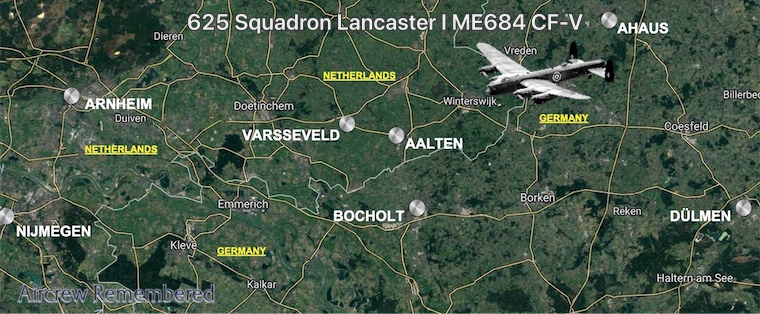
Unable to reverse his turret, John buckled on his parachute and made for the rear door. In the ensuing struggle to bale out his parachute deployed inside the aircraft. He bundled it across his chest and dove out and down through the rear door to miss the horizontal tailplane. There was no need to pull the ripcord and he descended uneventfully. John Remington had preceded him and the remainder of the crew baled out through the nose escape hatch. The aircraft crashed near the Dutch/German border. John Munro landed near Aalten in Holland. He along with Remington and Beckwith evaded capture.
The rest were PoW's. - all survived the war!
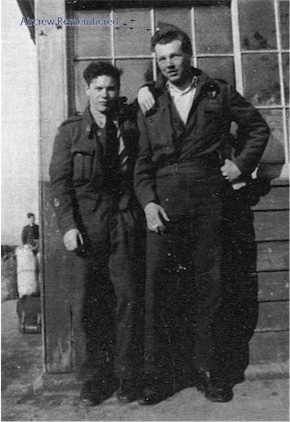
John Munro (shown on left with crew mate) was an evader from March to September 1944 with aid from the Dutch and Belgian Underground. On two occasions his escape path crossed that of Sgt. Remington at Zutphen and Liege. He was liberated in Hertal, Belgium by the American First Army. Dressed in a G.I. uniform he was transported by the “Red Ball Express” to Paris and finally England.
On return John paid a brief visit to the Squadron at Kelstern and the wives of Brand and Beckwith. After a month of leave in Canada he signed up for a second tour of ops. With a new crew he was posted to 431 (Iroquois) Squadron and flew in one mission to Wangerooge Island.
At the time of our conversation John informed me that he and Alex Bull were the only surviving members of their 1944 crew. He continued to be a member of the Royal Air Force Escaping Society.
At peace with his fate, John Munro died in Chilliwack, B.C. on Friday 13 2002, age 76.
During a second meeting on April 4 2001 John informed me of the circumstances that resulted in Sgt. John Remington assuming the position of mid-upper gunner for the March 24/25 Berlin raid. Their regular mid-upper gunner, Australian Richard “Dick” Martin, came to John the day before the raid in tears and said:
“Only birds and fools fly and birds don’t fly at night.” He was stripped of his rank and replaced by John Remington. He was put to use shovelling snow off the runways. He met up with John Munro after the war and stated that he was glad of his decision when their aircraft was shot down on the next mission and the crew declared: Missing In Action! (Addendum - Talisman/Lack of Moral Fibre, LMF).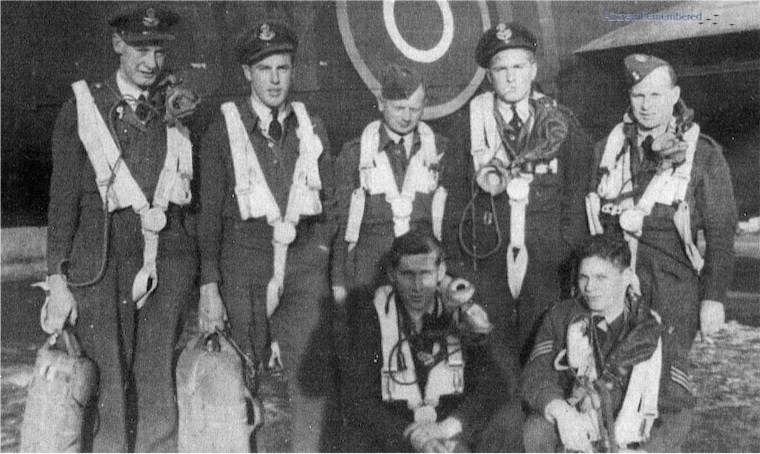
Above: Fl/Lt. Clark and crew at 1678 heavy conversion flight. Sgt. John Munro, right front kneeling, ? Fl/Lt. Clark back row second from right.
625 Squadron ORBs provide the following information which in general concurs with John Munro’s account. F/O. Clark and his crew arrived at Kelstern from 460 Squadron on February 19 1944 with Fl/Sgt. R.T. Martin in the position of mid-upper gunner. On 24.2.44 F/O. Clark had the privilege of flying as second pilot with Fl/Lt. E.S. Ellis CGM on the Schweinfurt raid. This proved to be an uneventful trip but was somewhat unusual as no other members of Clark’s crew were included as was the norm. Their first op, detailed to attack Augsburg on 25.2.44, the crew with Fl/Sgt. Martin as mid-upper gunner, was uneventful. Frankfurt was the target on 22.3.44 with Sgt. J.B. Remington serving as mid-upper gunner: A good quiet trip with fires visible 200 miles on homeward journey. For their third and final op the same crew in ME684, at 18.43 on 24.3.44, departed Kelstern for Berlin: 'Failed To Return'. No news after takeoff.
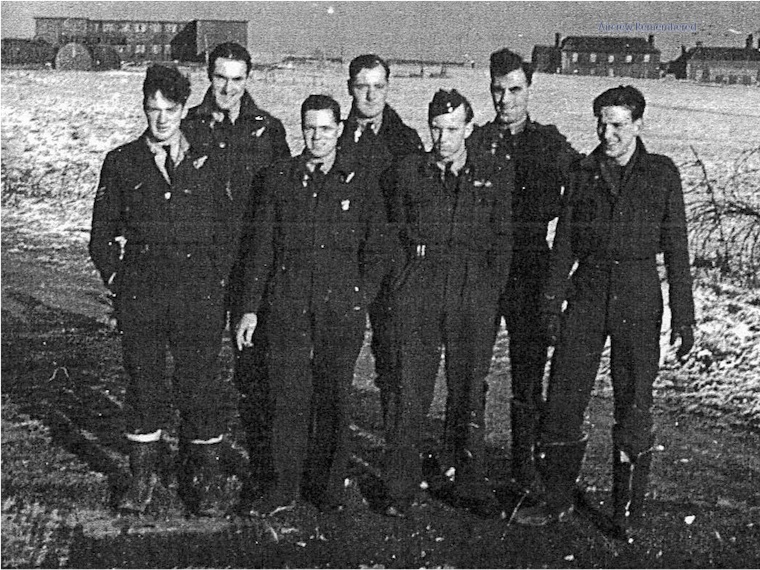
C.J.K. Bradshaw's crew (shown above with Sgt. John Remington far right)
It is noteworthy that Sgt. Remington arrived at Kelstern on January 13 1944 from 1656 HCU as the rear gunner of Fl/Sgt. C.J.K. Bradshaw’s crew (shown above). Other members included: Sgt. A.H. Brakes, flight engineer; Sgt. D.J. Gunn, air bomber; Fl/Sgt. J.E. Goldsmith, navigator; Sgt. R.F. Wright, wireless operator and Sgt. J.Sutcliffe, mid-upper gunner. On the evening of 27/28 January 1944 Fl/Sgt. Bradshaw along with Sergeants Remington, Gunn and Sutcliffe, had the privilege of crewing with W/Cdr. Preston DFC for an uneventful trip to Berlin. The next five ops with Fl/Sgt. Bradshaw as Skipper to Berlin (2), Leipzig, Stuttgart and Schweinfurt resulted in two aborts for technical reasons. Their seventh trip to Augsburg, 25/26 2 1944, was inauspicious: did not bomb target as r/gunner oxygen supply u/s. Bombed target last resort. This was Sgt. Remington’s last trip with the Bradshaw crew. He was replaced by Sgt. Jack Cavanaugh. It was almost a month before Sgt. Remington crewed up as mid-upper gunner in the Clark crew for their final two ops. Fl/Sgt. Goldsmith would serve a memorable wartime and aviation career spanning thirty-three years - retiring from the RCAF with the rank of Wing Commander. ND641 and PB302 Archive Reports. His decorations included the DFC, AFC an CD medal. He died peacefully on November 3, 2010 in Sidney, B.C. The author had the privilege of knowing him for the last decade of his life and is grateful to his son for sharing the contents of his personal War Diary.
The March 24/25 1944 Berlin raid proved to be the last major Bomber Command visit to the German capital. It became known as The Night of the Strong Winds that resulted in a widely scattered bomber stream - perfect conditions for the Nachtjagd. Of 811 aircraft detailed, 72 failed to return for an 8.9% loss rate! 625 Squadron paid dearly with the loss of three Lancs: ED317 - 7 KIA ), ND641 - 6 KIA, 1 Evader (More here) and ME684 - 4 POWs and 3 Evaders. It was quite rewarding for the author to locate John Munro, the rear gunner of ME684 and Frank Magee, ND641’s bomb aimer, living in the Fraser Valley of British Columbia less than twenty kilometres from each other - 56 years after these events.
For acts of valour, courage or devotion to duty: Suggested decoration, 55000 Fl/Lt. N.A.W. Clark DFC. Survivor’s eyewitness account.
Burial Details: None as entire crew survived. F/Os Armytage, Brand, Bull and Fl/Lt. Clark- PoWs; Sergeants Beckwith, Munro and Remington - evaders.
Addendum- Talismans and Lack of Moral Fibre (LMF)
It is rather sobering to observe the transition in facial expression of aircrew recruits from attestation photos to the ones taken just prior to posting over seas after several months of intense combat training - from the sweet innocence of bedazzled recruiting posters to the grim tasks at hand. Overseas the dismal odds of survival are reinforced by the combat vignettes of tour vets they encountered during their posting to Operational Training Units. By the time they reached an operational squadron there was little doubt that their chances of returning intact to their friends and family was extremely remote. Kevin Wilson, author of 'Men Of Air, The Doomed Youth of Bomber Command', provides the following example of a rookie aircrew’s introduction to an operational squadron: ‘When we first arrived on 101 Squadron the intelligence officer told us: “You’re now on an operational squadron, your expectation of life is six weeks. Go back to your huts and make out your wills” It was quite simply accepted that two out of three of us would be killed’. Sgt. Dennis Goodliffe, a 19-year-old flight engineer, who completed a thirty-three-operation tour in sixteen weeks in the spring and summer of 1944. This message was soon reenforced with increasing ops as crews failed to return, manifested by empty mess hall seats and Nissan bunks. On occasion a severely damaged bomber would crash on return to base or seriously injured or deceased airmen would have to be stretcher extracted under the watchful gaze of squadron mates.
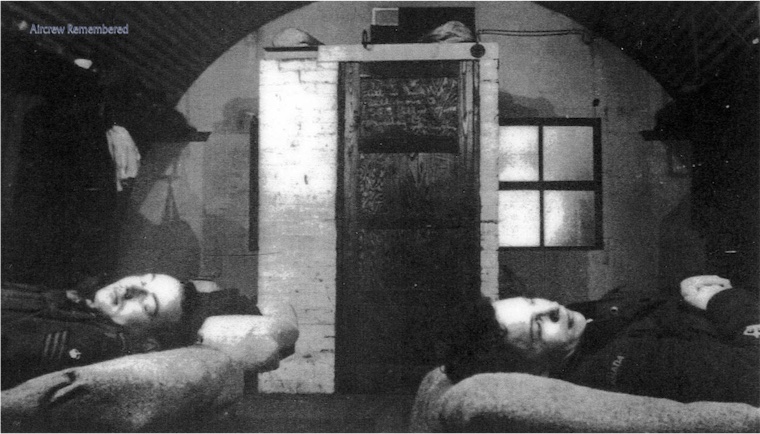
Above: The calm before the storm
It is difficult for the lay individual to conceive the terror faced by bomber crews as they lifted off in fading light for a trip over Nazi Occupied Europe. Murray Peden in his excellent publication, 'A Thousand Shall Fall', provides an insightful analogy of the intense strain during an operational flight: You are ordered to walk very slowly from one side to the other, then back, inside an enormous pitch black building. You are obliged to carry a pail of petrol and a shopping bag laden with dynamite in one hand. For defence you are are armed with a small calibre pistol. During the journey killers armed with tracer firing machine-guns have been alerted and are determined to find you with the intent to wound, incinerate or blow you into eternity. These killers can run twice fast as as you walk. Over the span of the five or six hour walk in darkness you are constantly reminded of the stakes of the ‘game’ by the sight of guns flashing in the dark and the great volcanic eruptions of flaming gasoline. To complete a tour of ops a crew had to walk this gauntlet at least thirty times with photographic evidence of having reached the target! This did not include aborted missions that may have been just as hair-raising. However, as terrifying as the scenario painted by Murray Peden was, he neglected to incorporate the one-two punch weapon system that tipped the table even further in favour of the fictional killers. This consisted of the modern equivalent of night vision goggles (SN-2 Air-borne Interception radar) coupled with high calibre weapons that could shoot vertically upward into your vulnerable belly (20-30 mm Schräge Musik cannons). In essence once located you had no place to run or hide. Bomber Command aircrew were deluded into thinking that there was safety in the dark of night or the cold dense cloak in the middle of a cloud. The combat report of Ofw. Bunje provided by Theo Boiten and Rod MacKenzie in Volume Two of the Nachtjagd War Diaries gives proof positive that a determined Nachtjagd pilot and crew could intercept and destroy a Lancaster concealed in a cloud cocoon, at night! It is also noteworthy that SN-2 radar negated the universal bomber pilot’s escape maneuver - the corkscrew. Out of sight but within radar range the Nachtjagd crew would shadow the bomber until it had resumed straight and level flight before closing in for a second attack.
Armed with this information and the grim statistics of raid loss rates it is difficult to understand how Bomber Command aircrew summoned the courage to attack a heavily defended German target - and repeat the horror thirty times to complete a tour of ops. Two raids had particularly high loss rates: Berlin, March 24/25 1944, 72 aircraft lost or 8.9% of the force and Nuremberg, March 30/31 1944, 96 aircraft lost or 10.1%. It is significant that the Nuremberg stats do not include the loss of aircraft and crew that crashed or crash-landed on English soil. This brings the loss total up to 108 with a rate of 13.6%! Sobering food for thought for the rookie crew at the start of their tour-a statistical lifespan of seven to eight missions, well short of the Holy Grail of thirty. A raid loss rate of 1-2% was palatable but anything above 3.3% meant that death would trump tour expiration. In retrospect the chance of surviving a tour of operations in Bomber Command was a depressing 40%.
With these grim statistics it makes one wonder what forces drove a young man in the prime of life to repeatedly face death with constant reminders of his presence with each trip into the void. One of the strongest determinants was the comradeship and devotion to a common cause, during a time of extreme, risky adventure. Significantly the coat of arms and motto of No. 625 Squadron, a Lancaster rose encircled by a seven link gold chain with We Avenge, emphasised the importance of teamwork and cooperation in attaining that common goal-survival. A common psychological defence mechanism was utilised by the majority of aircrew - denial. These horrors that I am witnessing will happen to the other crews but not mine. This was effective until the realisation hit home that we are the only original crew left on the Battle Order.
This was a time for talismans, superstitions and rituals- Blind luck and Black magic. Photos of aircrew in battle dress decorated with fancy scarves, ornamental pins or rabbits feet were common place. Stuffed animals had a halo of protective powers. A photo of W/O Edward Ellis CGM and his euphoric crew (shown below) after an op reveals that this battle hardened pilot has a teddy bear clutched in his hand! Many aircrew developed rituals in their pre-op tasks to reduce the intense stress in the time vacuum before departure. The number thirteen was avoided like the Black Plague. Unfortunately to get to op thirty to tour expire, they had to endure number thirteen. Many stumbled and fell on this one. Another symbolic ritual was the ‘watering’ of the tailwheel before climbing aboard. This action had the purpose of focusing the crew on pending challenges as a combat unit-clear minds, empty bladders. The tailwheel would symbolically kiss Mother Earth on return from a successful mission. Reg Price did not resort to a talisman or rituals. However on the homeward leg after an op, if he observed two bright stars in the western sky he felt quite certain that he would live to fly another trip. It is significant that on completing his tour he married their WAAF transport driver-a lifelong talisman!
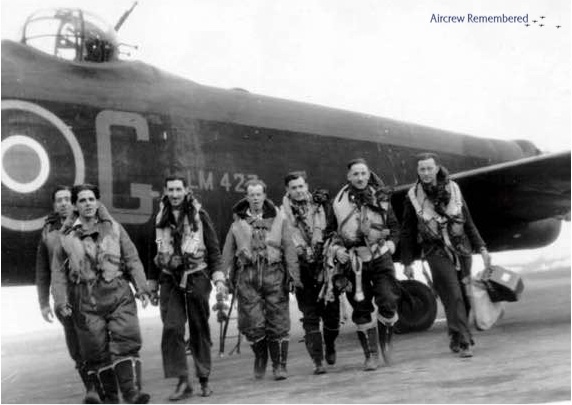
Fl/Lt. Ellis CGM and crew. Fl/Lt. Ellis third from left carrying a teddy bear.
After six weeks on an operational squadron a crew was entitled to a weeks leave, providing they survived that long. The first five trips had the highest loss rate as these crews had not gelled as a combat team-prime Nachtjagd targets. Leave and ops cancellations provided aircrew critical time to focus on the joys and distractions of life-wine, women, song and religion. The crews bent on survival ensured that alcohol was not a determining factor. The worst case scenario was to be called back early for an op with an inebriated crew mate. All it took was one crew member to be impaired, fall asleep at a critical moment, a night fighter delivers a two second precision attack-the rest is history.
It is quite remarkable that faced with impossible odds of survival, the aircrew of Bomber Command repeatedly returned to the fray. For most of us once would have been enough, thirty ops- never! It is difficult to conceive the courage and dedication to continue with a task that is most likely going to result in your violent traumatic death, in the prime of youth. Refusing to fly on ops was not an option. There but for the grace of God go I. Most went and failed to return. Those that refused to fly on ops were declared Lack of Moral Fibre (LMF). They were not cowards but realists who valued life. As a result they were paraded before their squadron mates, stripped of rank and assigned menial tasks. Their service record was stamped: LMF. On occasion they were court-martialled and rarely imprisoned. Russ Margerison, author of 'Boys at War', gives the perspective of an NCO on LMF. “The initials L.M.F. were well known in aircrew circles and periodically cropped up in conversation. It was a distasteful subject for it stood for ‘lack of moral fibre’. As will always happen in wartime some men (or should I say boys, for that is what we were) crack, and can go on no farther. When this happened the boy in question was sent to the Isle of Sheppey, reduced to the rank of AC2 and treated shabbily by men who had never set foot in an aircraft. This never ceased to annoy us and at no time did I ever hear one word of reproach against the ‘guilty’ person for we were only too well aware that it could happen to any of us. It lies purely in the mental make-up of an individual and one never knows how he will react to a given set of circumstances until tested. Flying was a peculiar job, as indeed were many jobs in the forces. One day a flight would be so thoroughly enjoyable one wanted to do it forever, the next could be so frightening you never wanted to see another plane.
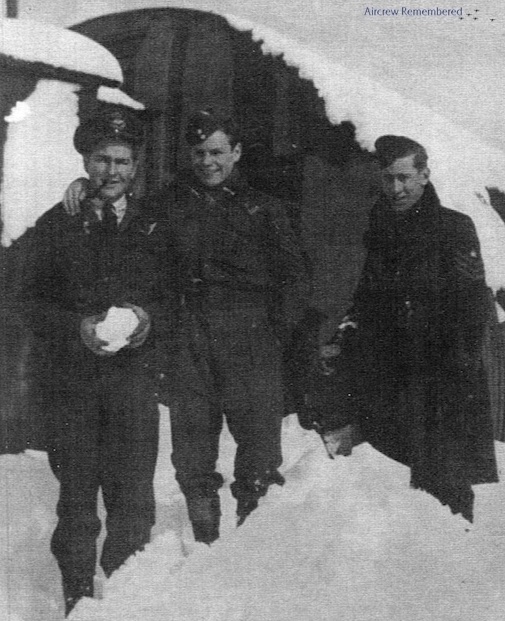
The day we got shot down. Fl/Lt. Clark on left, Sgt. John Munro centre, right ?
L.M.F. could work very unfairly when in fact the man lacked anything but moral fibre. Such was the case at Lindholme one afternoon when a Lanc taxied into the back of another, whist on the perimeter track, slicing through the rear turret and stopping a few feet short of the mid-upper turret, which was housed well to the rear in the Lancaster. The nineteen-year-old mid-upper-gunner, whom I knew well, sat there petrified, staring speechless at this huge monster, so close to his face, which had just gobbled up his best pal.
He eventually climbed out, walked slowly over to the flights section, ignoring everyone around, threw his helmet on the gunnery leader’s table and said simply: ‘I shall never climb into an aircraft again.’
That boy was posted immediately L.M.F. in accordance with the rules of the R.A.F. The Air Ministry were sticking rigidly to the view that all aircrew were volunteers and knew what they has volunteered to do.”
John Goldsmith in his personal War Diary provides an officer’s perspective of L.M.F.:
Aircrew Morale:
Throughout the war, morale on British bomber stations held up astonishingly well, although there were incidents of collapse during periods of high losses. Most of the crews of Bomber Command fought an unending battle with fear for most of their squadron tours, and some of them lost it. These were labeled “L.M.F.”- Lacking Moral Fibre, and in the period of terrible losses from April 1943 to August 1944 as many as one man in seven was lost to operational aircrew for morale or medical causes. During this period the “Early Return” rate from operations sometimes exceeded 25% of the aircraft dispatched. As opposed to the American bomber force where LMF was not considered a disgrace or dishonourable, the RAF Bomber Command was extremely harsh in handling such cases. Many aircrew so labeled were reduced to the ranks, stripped of their aircrew badge and spent the rest of the war on ground duties. In extreme cases some were court-martialled and even received prison sentences. The fact that some officers were able to bury themselves in Flying Training Command or in staff jobs rather than fly with operational squadrons did not escape the scornful notice of the operational aircrew and further reduced their morale.
The unfairness of the LMF policy is readily apparent when the cruel losses of men in RAF Bomber Command are known. A total of 55,573 aircrew, almost all officers and NCOs, among the finest and most highly trained material in the British Empire, were killed. A further 9,784 were shot down and taken prisoner. The pitiful prospects of surviving a tour of bomber operations were only matched in hazard on either side by the German U-boat crews.
These brave young men were anything but cowards as denoted by the term LMF!
In 'Men of Air', Kevin Wilson notes that NCOs were much more likely to be labeled LMF than officers. One reason being that the squadron’s Medical Officer would have regular exposure to commissioned aircrew in the mess to observe the signs and symptoms of combat fatigue. Recommendation for early leave or an administrative posting could prevent complete mental decompensation. Unfortunately NCOs were not offered the same degree of compassion and understanding. Court-martials were rare. On one occasion a married air gunner was sentenced to three years of penal servitude for intentionally damaging the oil feed pipe to his turret with a single blow of the emergency fire axe-resulting in the op being aborted. His wife was near term in her pregnancy. Shortly afterwards, with a replacement rear gunner, his entire crew was killed on ops.
The RAF opened several units to process aircrew not making a full contribution to the war effort. These included the Aircrew Refresher School at RAF Norton in Sheffield and convalescent, psychiatric centres at RAF Hospital at Rauceby, Wharnecliffe Hospital, Sheffield, Rockside RAF Hospital at Matlock, Derbyshire and Hackwood Park, Basingstoke (RCAF). These centres treated many aircrew suffering various stages of combat fatigue. One third recovered to return to operational flying in an attempt to complete their tour. In contrast the US Eighth Air Force was more compassionate in its dealing with combat broken airmen. Their rest homes were usually country estates with excellent food, sports and entertainment facilities. Those that could not be rehabilitated were returned stateside-without shame!
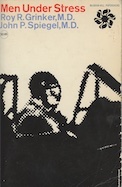
Two U.S. Army Air Force psychiatrists, Roy Grinker and John Spiegel, provide a fascinating study of combat neuroses in their book, 'Men Under Stress' - War neuroses in combat fliers. It is somewhat dated, 1945/1963, written for the lay individual, summarising their treatment of thousands of mentally wounded soldiers overseas. It includes sixty-five case histories that describe the reactions during and after combat, as well as the effects of psychotherapy, narcosynthesis and other treatments. i.e. Case 16: Severe depression resulting from repeated loss of comrades in combat.
The authors note that under sufficient stress any individual may show failure of adaption, evidenced by neurotic symptoms. Such symptoms are pathological only in a comparative sense, when contrasted with the symptoms of those still making successful adaptions. They point out that the goal of successful psychiatric selection is the weeding out of individuals with overt or latent neurosis, unhealthy neurotic motivation, low thresholds of anxiety endurance and those with behaviour problems and personalities that make group activity and teamwork difficult or impossible. The system was not infallible and they concluded that for the vast majority the only valid test for endurance of combat was combat itself.
Combat stress was associated with enemy activity: fighters, flak and loss of friends. Interestingly the impersonal, inexorable and deadly accurate flak was a greater source of anxiety - “If I don’t get you today, I’ll get you tomorrow”.
Morale or the motivation for combat is the major determinant in the rate of early returns and combat neurosis. Competent leadership is essential for good morale. This includes strength in character, decisiveness, good judgment, justness and impartiality, while giving every consideration to the creature comforts of his men on a concrete level in so far as the military situation allows. If individuals fail in their duty through lack of loyalty and unwillingness to make an effort they must be firmly dealt with. Promptness in punishment was important in maintaining good morale.
Psychological deficiency resulting from combat stress was of the greatest practical concern because no one was immune. Prolonged severe stress could strike an exposed “Achilles’ heel” leading to the development of adverse psychological symptoms in anyone. Once symptoms developed it depended on medical and military judgment how much longer the airman could be exposed to combat and what could be done to remedy the situation. Initially airmen were eager, enthusiastic, cool and competent in the face of harrowing encounters. However the unending strain produced distress signals that affect any part of the mind or body: battle fatigue, permanent anxiety, anorexia, vomiting, diarrhoea, sleep disorders, irritability, depression and isolation. Forgetfulness, preoccupation and brooding destroyed purposeful activity. Behaviour may become asocial, inappropriate and bizarre-conditions obviously incompatible with combat duties, leaving the airman and his crew mates vulnerable.
On presentation disabled individuals were diagnosed as one of five categories: free anxiety states of various intensities, phobic states, conversion states, psychosomatic states and depressions. Some degree of free anxiety was often inter-mixed with the other categories.
Early treatment by Flight Surgeons in the theatre of operations was concerned with prevention and intervention. If initial efforts failed to prevent disabling neurotic symptoms the airman was removed from his combat organisation for definitive psychiatric care and disposition. Flight Surgeons could reduce stress by reducing the frequency of missions or referring the airman to a rest camp. Barbiturates were used to control a flier’s sleep and after a severe shock with moderate sedation under sodium amytal for twenty-four to forty-eight hours. Psychiatrists would assess and treat refractory cases with psychotherapy and often narcosynthesis with pentothal. The latter technique often resulted in dramatic improvement after just one or two sessions with reduced symptoms and increased insight. The case presentation interviews are fascinating in revealing repressed combat anxieties and their resolution through abreaction.
The authors present the results of almost 3,000 officers and enlisted men discharged from the Don Cesar Convalescent Hospital. In summary 97.7% of officers and 79.1% of enlisted men returned to some form of military duty. As a second tour of combat duty was not policy, they point out they were unable to test the efficiency of their treatment in enabling a flier to return to combat.
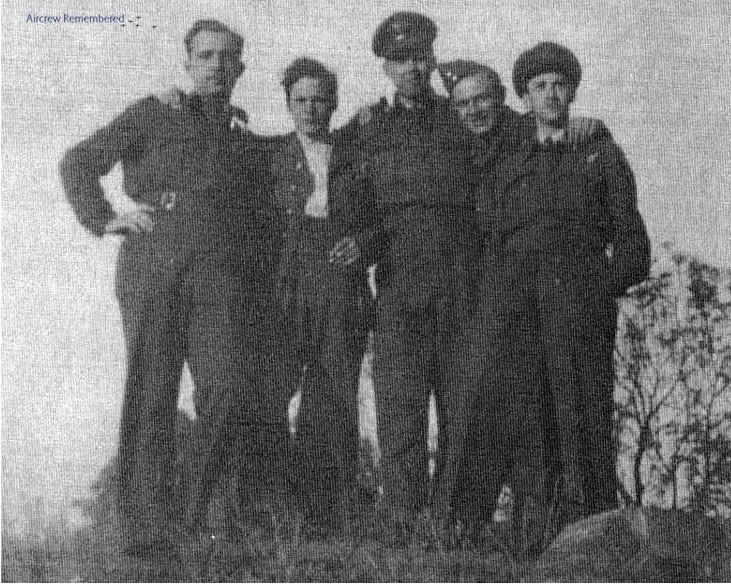
Second tour, one op with 431 (Iroquois) Squadron, Sgt. John Munro 2nd on left.
Leadership and morale bring to mind an exceptional individual who is a pillar in the historic halls of Bomber Command: W/Cdr. Leonard Cheshire VC, OM, DSO and two Bars, DFC. Although an advocate for the Lack of Moral Fibre policy, Cheshire epitomised the role of leader by never flinching from the responsibility of the tasks at hand, especially when the chosen target was one of the most heavily defended. Despite four tours of ops, he did not reach his breaking point of combat stress-testimony to his impregnable psychological foundation. During his later tours he did not have his own crew and would fly as second ‘dickie’ of a rookie crew on their first op. One can only imagine how confidence inspiring it would have been to have the WingCo at their sides to ensure a safe return. During one trip as the Master of Ceremonies he pulled off an amazing feat: Flying for the first time a P-51 Mustang he marked within a few feet the concrete roof of the flying bomb launching and storage site at Siracourt - all without the luxury of a navigator! His precision marking resulted in total destruction of the target. The award of the VC was unusual in that it recognised his completion of four tours of operational duty with Bomber Command and not one particular act of valour, despite the fact that the award was merited on numerous prior occasions. His 103rd op on August 9, 1945 was as a special observer aboard an American B-29 Super-Fortress to witness the dropping of an atomic bomb on Nagasaki-resulting in Japanese capitulation.
During the postwar era, Cheshire was recognised for his philanthropic and humanitarian achievements. In particular he was responsible for founding centres for Bomber Command vets who were permanently disabled as a result of their combat experiences. This was accomplished despite his hospitalisation for tuberculosis therapy. At age seventy-four he succumbed to motor neuron disease (Lou Gehrig’s disease or amyotrophic lateral sclerosis/ALS) on July 31 1992 - survived by his wife Baroness Ryder, son Jeremy and daughter Elizabeth.
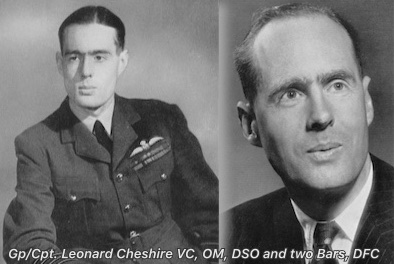
Taking into account the above information it is difficult to comprehend the diametrically opposed attitudes and treatment of the victims of combat neuroses by British and American senior staff. On one hand the Americans flexible and compassionate, on the other the British rigid, punitive and demeaning. It is difficult to understand that it took almost seventy years for the British and Commonwealth countries to recognise the courageous young men of Bomber Command for their crucial contribution to the final victory with the introduction of the Bomber Command Operational Bar-an award that few lived to receive. In 2012 volunteer donations culminated with the unveiling of the hauntingly symbolic Bomber Command statue in London, UK.
In essence these young airmen, along with their crew mates, were coerced into playing Russian Roulette, not once but thirty times-with a 40% chance of survival. A subtle difference was that they would not be pulling the trigger. They did not know by who or when - Nachtjagd experten or radar-guided flak battery commander. This was most definitely NOT what they had volunteered for!
“…Theirs is a world you’ll never know
Lie in the dark and listen.”
Noel Coward
Webmaster note: Read this wonderful poem here
On December 1,1919 King George V, at the request of the Canadian Cabinet of Prime Minister Robert Borden established the Memorial Cross (Silver Cross). This medal was awarded to the mother, widow or next of kin of any member of the Canadian Forces who lost their life in active service, including peacekeeping and other such international operations. It was initially intended to recognise the sacrifice of sailors, soldiers and airmen killed in action during World War One but continues to be awarded to date. Annually a Silver Cross Mother is chosen from the ranks of mothers who have received the Memorial Cross, for Remembrance Day commemorations on November 1st. This decoration was awarded to the next of kin of all members of the RCAF KIA serving with Bomber Command in recognition of their sacrifice.
In addition any member of the RCAF KIA during active service with an RAF bomber squadron was awarded the Operational Wings and Citation. These awards were greatly appreciated and revered by next of kin.
For some reason the government of Britain has been unable to find the foresight, wisdom and compassion to give similar recognition to the young airmen that scarified their lives to ensure victory. The introduction of the Bomber Command Bar in 2012 for the rapidly declining number of surviving vets was a drop in the bucket and most importantly did not acknowledge those airmen KIA. There are several options that could be pursued: Do nothing, follow the Canadian example or amend the existing award system for posthumous and exceptional situations. The Distinguished Flying Cross and Medal were awarded to airmen serving with the RAF for “an act of valour, courage or devotion to duty while flying in active operations against the enemy”. Officers qualified for the DFC and enlisted men the DFM. There can be no doubt that the loss of ones life would fulfil the condition of devotion to duty! With this in mind it would be reasonable that all airmen KIA with Bomber Command were deserving of the DFC or DFM depending on rank. Under circumstances of unusual courage the Victoria Cross or Conspicuous Gallantry Medal would be appropriate - LM513 and LL956 of 625 Squadron. A similar argument could be applied to aircrew killed in training accidents. For them the outcome was the same as was the impact on their next of kin. Airmen that survived to become evaders or PoWs also fulfilled the criteria and the latter may have lost up to four years of their youth in captivity. Any airman that survived a tour of ops deserved the award of the DFC or DFM - a second tour a Bar, a third tour a second Bar and the fourth the VC (G/C Leonard Cheshire being the sole example). For the majority these decorations would now be posthumous but would go a long way to healing the wounds of protracted oversight for surviving next of kin. It is never too late to rectify a wrong. 'Lest We Forget'.
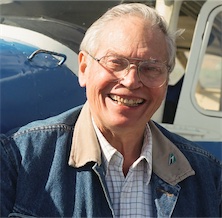
Left: John Munro 2001
Co-Authors:
George Munro- son of John Munro
Reg Price DFC, 625 Squadron veteran
References:
Boys at War - Russell Margerison/ Northway Publications
Men of Air, The Doomed Youth of Bomber Command - Kevin Wilson
A Thousand Shall Fall - Murray Peden
Nachtjagd War Diaries Volume Two - Theo Boiten and Roderick MacKenzie
Men Under Stress- Roy R. Grinker, M.D., John P. Spiegel, M.D.
Cheshire V.C.- Russell Braddon No Passing Glory, The Full and Authentic Biography of Group Captain Cheshire - Andrew Boyle
Interview notes 2001-John Munroe, rear gunner 625 Squadron
Personal War Diary of G/C (Ret) John E. Goldsmith, courtesy John Goldsmith Jr.
Wikipedia: Memorial Cross
Photographs:
Sgt. John Munro - courtesy son George Munro
Fl/Lt. Ellis CGM and crew - courtesy Eileen Edge and son Kevin Ball
G/Cpt. Cheshire VC - Russell Braddon, Air Ministry
Baron - Andrew Boyle
Men Under Stress - JEA
Bradshaw crew with John Remington - Personal War Diary of G/Cpt. (Ret) John E. Goldsmith
The tragic world of the majority of Bomber Command aircrew - photos are located on page 402 of the Bomber Command War Diaries (Hardcover,1985)
Memorial Cross- JEA
Submission by Jack Albrecht and Nic Lewis.
Crew and home towns:
Fl/Lt. Norman Clark, London, England
Sgt. Donald Beckwith, Yorkshire, England
F/O. Alex Bull, Calgary, Alberta, Canada
F/O. George Brand, Sale, England
F/O. Peter Armytage, Coleraine, Australia.
Sgt. John Remington, Wolverhampton, England.
Sgt. John Munro, Fort William, Ontario, Canada.